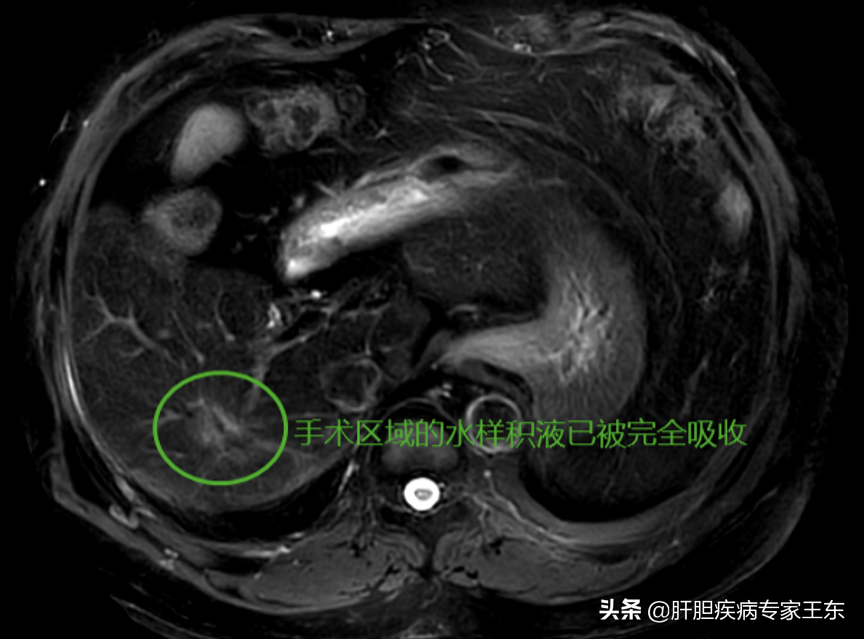【Basic information】Patient, male, 55 years old
【Disease type】Primary liver cancer (hepatocellular carcinoma, hyperdifferentiation, CNLC Ib), chronic hepatitis B, post-splenectomy
【Treatment Hospital】Peking University People's Hospital
【Treatment plan】Partial liver resection + radiofrequency ablation
【Treatment period】4 years and 11 months
【Treatment result】Rehabilitation (no recurrence of tumor)
First, the first acquaintance with the patient
The first time I saw this patient was in the outpatient clinic, brought by his family from abroad to Beijing for treatment, a 55-year-old male middle-aged patient, because of the physical examination found that the liver occupied the position for 9 days. Nine days ago, the patient did a chest CT to suggest a low-density lesion in the liver because the chest X-ray suggested "interstitial lesions of both lungs and an infection of the lower left lung", considering mass lesions. The patient also re-examined the abdominal MRI to suggest: hepatic VI segment mass lesion, about 4.6 * 5.9 cm in diameter, peripheral epidermis, its internal signal is uneven, consider malignancy. After outpatient inquiry, the patient has no abdominal pain, bloating and other uncomfortable symptoms, since the onset of the disease, spirit, sleep can be, appetite is good, the stool is as usual, and there is no significant change in weight. Previous: Abdominal and splenectomy performed 33 years ago due to trauma in a car accident, with a history of blood transfusion. 14 years ago, the examination found that hepatitis B was "little three yangs" and no antiviral treatment was carried out. Outpatient clinics are included in our department as "liver occupancy".
2. Admission to the hospital for physical examination and auxiliary examination
1) Stable vital signs, abdominal bulging, no intestinal type, no peristalsis waves, abdominal breathing presence, abdomen see splenectomy surgical incision scars, abdominal wall veins without varicose, abdominal wall softness, abdominal muscles without tension, no rebound pain, negative Murphy signs, liver untouched, no mass in the abdomen, negative mobile voicedness, no percussion pain in both renal areas, normal bowel sounds, 4 times / min, no air-passing sound, no blood vessel murmurs.
2) Chest CT (our hospital): both lungs scattered in a flaky ground glass shadow, considering the possibility of poor lung ventilation caused by bronchitis; suspicious right lung micronodular shadow, if necessary interval review, bilateral hilar and mediastinum multiple swollen lymph nodes, intrahepatic hypodermic foci, consider mass lesions. A 2.0*1.7 cm size nodule shadow is seen posterior to the gastric cardia area, and the boundary is clear, considering the possibility of paranodonomy.
3) Abdominal MRI (our hospital): hepatic VI segment mass lesion, about 4.6 * 5.9cm in diameter, peripheral to see the envelope, its internal signal is uneven, consider malignant. Multiple lymph nodes in the abdominal cavity and retroperitoneum, absence after spleen surgery, multiple abnormal signaling of the pancreatic tail and left side of the abdominal aorta, considering postoperative changes, fatty liver, double kidney cysts, the edge of the lesion in the lower part of the right kidney is not polished, and the suspicious abnormal signaling of both lungs.
3. Diagnosis and diagnostic basis and differential diagnosis
1) Hepatic mass (mesophyllum-derived tumor): According to the patient's abdominal MRI suggesting that the hepatic mass lesion has a hemorrhagic component, considering the possibility of mesophyllum-derived tumors, such as undifferentiated sarcoma, etc., it is necessary to distinguish from hemangioma with bleeding, and consider the diagnosis, it is necessary to distinguish from the following diseases:
- Benign tumors of the liver: such as hepatic hemangiomas, hepatic cysts, cysts, etc. It is mainly manifested as symptoms such as epigastric discomfort, bloating, belching, abdominal pain and other symptoms after compressing the surrounding organs, and the final diagnosis is based on pathology.
- Liver metastases: mostly have a history of primary tumors, mostly from the abdominal viscera, such as stomach cancer, colon cancer, gallbladder cancer, pancreatic cancer, endometrial cancer or ovarian cancer, etc., clinical manifestations are mainly symptoms caused by primary tumors, can appear liver area pain, serum AFP is mostly negative. The final diagnosis depends on pathology.
2) Fatty liver: imaging is provided, considering the possibility of diagnosis.
IV. Treatment:
Under general anesthesia, open abdominal hepatic S6 segment resection + cross-sectional radiofrequency ablation, postoperative pathology: (liver S6 segment) excision specimen: hyperdifferentiated hepatocellular carcinoma, about 5 cm in diameter, peripheral liver tissue showing nodular cirrhosis, focal area visible intraveal carcinoma embolus.
Name of the procedure: Partial hepatic resection + radiofrequency ablation (W).
Preoperative diagnosis: primary liver cancer, post-hepatitis B cirrhosis, portal hypertension, post-splenectomy.
Postoperative diagnosis: primary liver cancer, post-hepatitis B cirrhosis, portal hypertension, post-splenectomy.

V. Precautions for patients after discharge
1) Pay attention to protecting the wound after discharge, change the dressing after 2 days of discharge, and remove the stitches according to the situation.
2) Continue oral hepatoprotective and anti-hepatitis B virus drugs after discharge.
3) 2 weeks after discharge from the hospital, our department will follow up with outpatient clinics.
4) Eat a reasonable diet and control your weight.
5) Discomfort follow-up.
Sixth, the doctor's understanding
1) The patient is also a liver cancer developed from hepatitis B and cirrhosis, and the preoperative state is "small three yangs", and the postoperative needs to take oral antiviral drugs for life (the patient eats Subifu).
2) The patient's cirrhosis is more severe, and the preoperative liver reserve function test ICG-15R exceeds 10%, but the liver function test index is A grade, and surgery can be tolerated.
3) Science Alley - the patient's pathological diagnosis mentioned vascular carcinoma suppositories, so what is vascular carcinoma suppositories?
The so-called vasculature, that is, the lymphatic vessels or blood vessels around the tumor (including hepatic arteries, hepatic veins and portal veins), vascular carcinoma embolus often refers to the spread of cancer cells in the tiny vasculature around the tumor. In patients with implanted tube cancer suppositories, the risk of tumor recurrence and distant metastasis increases after surgery. Therefore, some treatment measures are needed to reduce the probability of recurrence after surgery, and the most commonly used technique is the hepatic artery perfusion chemotherapy introduced earlier.
This article was co-authored by Wang Dong and Zhang Longhui.